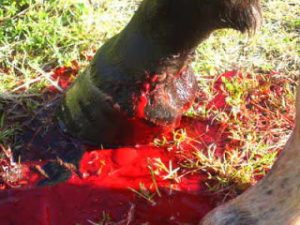Large animal wounds
Vascular damage
Blood loss
Arterial bleeding requires rapid hemostasis. If the animal will tolerate it, the owner can be asked to apply tight bandages or pressure while waiting for the veterinarian. Under veterinary care, bleeding may be controlled by ligatures, clamps and/or a fresh pressure bandage. Tourniquets can be placed and maintained for ~30min with minimal risk.

Historical blood loss can be assessed through the physical examination. Horses with low blood volume will have elevated heart and respiratory rates and may have pale mucous membranes. The PCV and TPP will not change until the horse is rehydrated as the relative amounts of red blood cells remain stable with whole blood loss.
Horses with blood loss should be kept calm and referred to a hospital capable of plasma therapy or blood transfusions. Acepromazine should not be used to sedate the horse due to the drug’s hypotensive effects.
Vascular spasm
Vascular spasm and vessel obstruction occur most commonly with suspensory breakdown injuries and with limb strangulation(wire wrapped around the limb). Heparin and warmth are usually not sufficient to prevent clotting and fibrosis of the lumen. The limb must be amputated or the animal euthanized. Limb amputations in larger animals are challenging and often lead to inhumane recovery periods. This may change in the future.
Key Takeaways
Large animals have large blood volumes and can tolerate more than 5 liters of blood loss without needing a transfusion. Just don’t give them acepromazine.
Blood supply is essential for healing. A cold limb means it won’t heal.
Resources
Wound Management: Wounds with Special Challenges, VCNA Vol.34(3), pp.511-538, 2018

